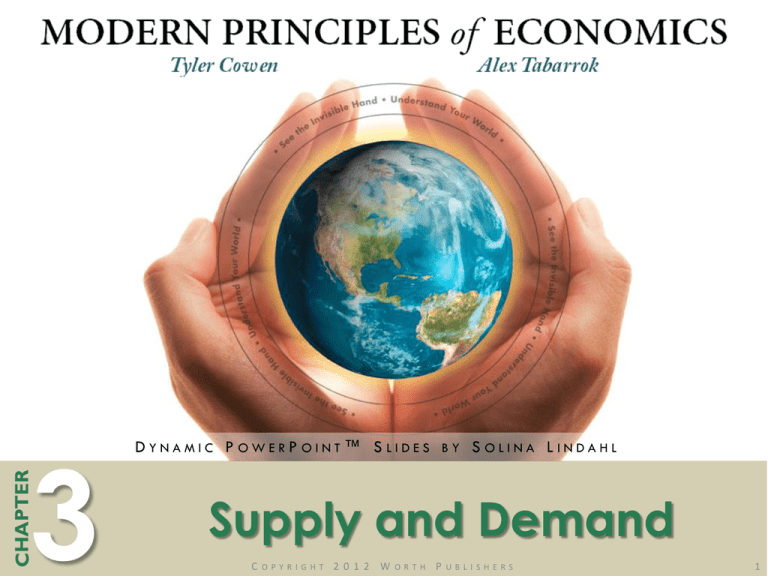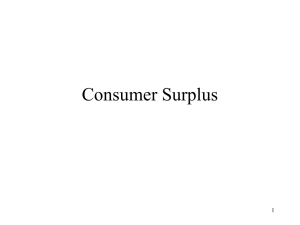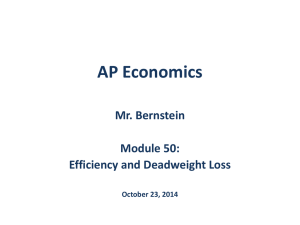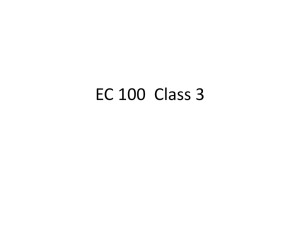
CHAPTER
3
DYNAMIC P OWERP OINT™ S LIDES BY S OLINA L INDAHL
Supply and Demand
C
OPYRIGHT
2012 W
ORTH
P
UBLISHERS
1
CHAPTER OUTLINE
Demand curve
Supply curve
Quantity demanded
Quantity supplied
Consumer surplus
Producer surplus
Total consumer surplus
Total producer surplus
Normal good
Inferior good
Substitutes
For applications, click
here
Complements
To Try it!
questions
2
Food for Thought….
Some good blogs and other sites to get the juices flowing:
3
Demand
What made him buy it?
4
BACK TO
Demand
Demand represents the behavior of
buyers.
A Demand Curve shows the quantity
demanded at different prices.
The Quantity Demanded: the quantity
that buyers are willing (and able) to
purchase at a particular price.
5
BACK TO
Law of Demand
Price and Quantity Demanded are
negatively related
6
BACK TO
The Demand Curve
The Demand Curve for Oil
Price of
Oil per
Barrel
$55
$20
$5
Quantity
Demanded
$55
5
$20
25
$5
50
Demand
5
7
Price
25
50
Quantity of Oil
(MBD)
BACK TO
Reading Demand Curves
Demand curves can be read in two
ways:
Horizontally: How much buyers are
willing and able to purchase at a
certain price.
Vertically: The highest price buyers are
willing to pay for a certain quantity.
8
BACK TO
Intuition of the Demand Curve
When the price is high,
oil will only be used in
the high value
products. If the price
falls, oil will also be
used in lower value
products.
Price of
Oil per
Barrel
Higher
Valued Uses
of Oil
$120
Lower
Valued Uses
of Oil
$20
Demand
9
20
120
Quantity of Oil
(MBD)
BACK
T O
Consumer Surplus
Consumer Surplus is the consumer’s
gain from exchange,
the difference between the highest
price a consumer will pay at a given
quantity and the actual market price.
Total consumer surplus is the sum of
consumer surplus of all buyers.
10
BACK TO
Try it!
Your roommate just bought an iPad for
$600. She would have been willing to pay
$1,000 for a machine that could make her
life so much more worthwhile. How much
consumer surplus does your roommate
enjoy from the iPad?
a) $600
b) $400
c) $1600
d) $1400
To next
Try it!
Consumer Surplus
Consumer Surplus is the Area beneath the Demand Curve and above the Price
Price of
Oil per
Barrel
Area of Triangle
80
Height
The President’s
Consumer
Surplus
Total Consumer Surplus
at a Price of $20
½(80-20)x90
= $2,700
Base
Joe’s Consumer
Surplus
20
Demand
90
12
½(Base x Height)
Quantity of Oil (MBD)
BACK TO
Try it!
If the price is $2010, what is the consumer
surplus?
a) $3,588,000
b) $1,794,000
c) $6,000,000
d) $3,000,000
To next
Try it!
What Shifts the Demand Curve?
An “increase in demand” means
that consumers buy more at every
price level, (or consumers are willing
to pay more for each quantity.)
On the graph: the demand curve shifts
outwards, up, and to the right.
14
BACK TO
What Shifts the Demand Curve?
A “decrease in demand” means that
consumers buy less at every price
level, (or they reduce the price
they’re willing to pay for a given
quantity.)
On the graph: the demand curve shifts
inwards, down, and to the left.
15
BACK TO
A Decrease in Demand
Price per
Unit
Lower Willingness to Pay
for the Same Quantity
$50
Less Quantity Demanded at
the Same Price
$25
Old Demand
Curve
New Demand
Curve
70
16
80
Quantity
BACK TO
An Increase in Demand
Price per
Unit
$50
Greater Willingness to
Pay for the Same
Quantity
Greater Quantity Demanded
at the Same Price
$25
New Demand
Curve
Old Demand
Curve
70
17
80
Quantity
BACK TO
Demand Shifters
Important Demand Shifters:
1. Income
2. Population
3. Price of Substitutes
4. Price of Complements
5. Expectations
6. Tastes
18
BACK TO
Important Demand Shifters:
Income
1. The effect of changes in income on
demand depends on the nature of
the good in question.
A Normal Good: demand increases
when income increases (and vice
versa).
An Inferior Good: demand decreases
when income increases (and vice
versa)
19
BACK TO
Try it!
When the price of petroleum goes up,
the demand for natural gas ______, the
demand for coal ______, and the
demand for solar power ______.
a) increases; increases; increases
b) increases; increases; decreases
c) decreases; decreases; increases
d) decreases; decreases; decreases
To next
Try it!
Important Demand Shifters:
Population
2. As the population of an economy
changes, the # of buyers of a
particular good also changes,
(thereby changing its demand.)
What happens to the demand for
diapers in Russia as birth rates drop?
21
BACK TO
Important Demand Shifters:
Price of Substitutes
3. Two goods are Substitutes if a
decrease in the price of one leads
to a decrease in demand for the
other (or vice versa).
- What happens to the demand for
travel in Hawaii if the (perceived)
safety cost of traveling to Mexico
increases?
22
BACK TO
Important Demand Shifters:
Price of Complements
4. Two goods are Complements if a
decrease in the price of one good
leads to an increase in the
demand for the other (or vice
versa).
What happens to the demand for Sport
Utility Vehicles when gasoline gets
more expensive?
23
BACK TO
Price of Complements
Consumers often have to buy goods
together.
An increase in price of gasoline will
decrease the demand for SUVs
24
BACK TO
Important Demand Shifters:
Expectations
5. The expectation of a higher (lower)
price for a good in the future increases
(decreases) current demand for the
good.
Consumers will adjust their current
spending in anticipation of the direction of
future prices in order to obtain the lowest
possible price.
If prices for Xbox 360 consoles are expected
to drop right before Christmas, what will
happen to sales during November?
25
BACK TO
Important Demand Shifters:
Tastes
6. Tastes and preferences are
subjective and will vary among
consumers.
Seasonal changes or fads have
predictable effects on demand.
What happens to demand for boots
in October? To carbohydrates during
the Atkins diet fad? Or to Acai
berries after newly perceived health
benefits?
26
BACK TO
What Shifts the Demand Curve?
A “change in quantity demanded” is NOT the
same as a “change in demand.”
“Quantity demanded” changes only when
the price of a good changes.
It is a movement along a fixed demand curve.
“Demand” changes only when a non-price
factor (demand shifter) changes.
It is a shift in the entire demand curve.
A “change in Quantity
Demanded”
27
A “change in
Demand”
BACK TO
Try it!
When the price of a good increases the
quantity demanded ______. When the price
of a good decreases the quantity
demanded ______.
a) rises; rises
b) rises; falls
c) falls; rises
d) falls; falls
To next
Try it!
Supply
What made this oil field happen?
29
BACK TO
Supply
Supply represents the behavior of
sellers.
A Supply Curve shows the quantity
supplied at different prices.
The Quantity Supplied is the quantity
that producers are willing and able to
sell at a particular price.
30
BACK TO
Law of Supply
What do you think happens to the
quantity of human organs donated in
Israel when the government issues a point
system that rewards donors?
The Law of Supply: there is a direct
relationship between price and quantity
supplied.
When price rises, all else equal, quantity
supplied rises and vice versa
31
BACK TO
The Supply Curve
Price of Oil
per Barrel
The Supply Curve for Oil
Supply Curve for Oil
$55
$20
Price
Quantity
Supplied
$55
50
$20
30
$5
10
$5
10
32
30
50
Quantity of Oil
(MBD)
BACK TO
Reading Supply Curves
Supply curves can be read in two
ways:
Horizontally: How much suppliers are
willing and able to sell at a certain
price.
Vertically: The minimum price for which
suppliers are willing to sell a certain
quantity.
33
BACK TO
Supply Curves
Why is the supply curve upward
sloping?
The cost of producing a good is not
equal across all suppliers.
At a low price, a good is produced
and sold only by the lowest cost
suppliers.
At a high price, a good is also
produced and sold by higher cost
suppliers.
34
BACK TO
The Supply Curve for Oil
Price of
Oil per
Barrel
The Supply Curve for Oil
Supply
$60
Oil Shale
Profitable
Here
$40
Higher Cost Oil
Low Cost Oil
$20
20
35
40
60
80
Quantity of Oil
100 (MBD)
BACK TO
Furthermore…
Does sex have a “price?” See this blog post for a discussion about changes in
supply and demand for sex.
36
BACK TO
Producer Surplus
Producer Surplus is the producer’s gain
from exchange
the difference between the market price and
the minimum price at which producers would
be willing to sell a certain quantity.
Total producer surplus is the sum of the
producer surplus of each seller.
Graphically, total producer surplus is
measured by the area above the supply
curve and below the price.
37
BACK TO
Producer Surplus
Producer Surplus is the Area Above the Supply Curve and Below the Price
Price of Oil
per Barrel
$60
Supply Curve
$40
$20
Total Producer Surplus at
a Price of $40
20
38
40
60
80
Quantity of Oil (MBD)
BACK TO
Try it!
Using the following diagram, calculate
total producer surplus if the price of oil is
$50 per barrel.
a) 0
b) $45
c) $1,350
d) $2,700
To next
Try it!
Change in Supply
Price of
Oil per
Barrel
$50
Old
Supply
Greater
Quantity
Supplied at
the Same
Price
New Supply
$10
Lower Costs Increase Supply
Willing to
Sell Same
Quantity at
Lower
Prices
20
40
80
Quantity of Oil
(MBD)
BACK TO
Change in Supply
New Supply
Price of
Oil per
Barrel
Smaller
Quantity
Supplied at the
Same Price
Old
Supply
$10
Higher
Price
Needed to
Sell Same
Quantity
Higher Costs Decrease
Supply
20
41
80
Quantity of Oil
(MBD)
BACK TO
Supply Shifters
Important Supply Shifters
1. Technological Innovations
2. Input Prices
3. Taxes and Subsidies
4. Expectations
5. Entry or Exit of Producers
6. Changes in Opportunity Costs
42
BACK TO
Important Supply Shifters:
Technological Innovations
1. A technological innovation makes
sellers willing to offer more at a given
price, or sell a their quantity at a lower
price.
A technological innovation lowers costs
and increases supply.
43
BACK TO
Production Technology
Supply will increase for products
when technology improves
Examples: Computers, gaming systems, laser
hair removal, flat screen TVs.
44
BACK TO
Important Supply Shifters:
Input Prices
2. A decrease in the price of an input (all
else equal) increases profits and
encourages more supply (and vice
versa)
What will happen to the amount of new
businesses if the government reduces the
fees and red tape associated with new
business licenses? What happens if the fees
rise?
45
BACK TO
Important Supply Shifters:
Taxes and Subsidies
3. A tax on output reduces profit and
makes sellers less willing to supply at a
given price, unless they can effectively
raise the price without losing any sales.
(for now, assume they cannot)
A tax on output raises costs and decreases
supply.
Graph the effect on supply of a new cigarette
tax in your notes.
46
BACK TO
Important Supply Shifters:
Taxes and Subsidies
A subsidy on production makes sellers
willing to supply a greater quantity at a
given price, or the subsidy allows
producers to sell a given quantity at a
lower price.
A subsidy on production lowers costs and
increases supply.
Graph the effect on supply of a new subsidy
to fast food producers aimed at helping them
market and sell overseas.
47
BACK TO
Taxes and Subsidies
Taxes and subsidies affect profits and
therefore supply.
A 10% yacht tax reduced the supply of yachts
53% in the early 1990s.
48
BACK TO
Cotton Supply
When the U.S. decreases its cotton subsidies,
U.S. cotton supply decreases
49
BACK TO
Important Supply Shifters:
Taxes and Subsidies
With a $10 Tax Suppliers Require a $10 Higher Price to Sell the Same Quantity
Price of
Oil per
Barrel
Supply With $10 Tax
$10
$10
$10
$50
Supply Without Tax
$40
50
60
Quantity of Oil (MBD)
BACK TO
Important Supply Shifters:
Expectations
4. The expectation of a higher price for a
good in the future decreases current
supply of the good – if they can store
the good- (and vice versa).
Sellers will adjust their current offerings in
anticipation of the direction of future
prices in order to obtain the highest
possible price.
51
BACK TO
Future Expectations
A change in producers’ expectations
about profitability will affect supply
curves
Windmill production increases as
producers expect sales and profitability
to increase.
52
BACK TO
Important Supply Shifters:
Expectations
Expectations Can Shift the Supply Curve
Price
per Unit
Supply Today with
Expectation of
Future Price
Increase
Supply Today
Into Storage
Quantity
53
BACK TO
Important Supply Shifters:
Entry or Exit of Producers
5. As producers enter and exit the
market, the overall supply changes.
Entry implies more sellers in the market
increasing supply.
Exit implies fewer sellers in the market
decreasing supply.
What will happen to the supply for Marijuana
in California if the drug is legalized for general
use?
54
BACK TO
Number of Producers
As more producers enter a market, supply
increases (and vice versa)
As more firms enter
the solar installation
market, the number
of solar installations
available for sale
increases
55
BACK TO
Important Supply Shifters:
Entry or Exit of Producers
Entry Increases Supply
Price
Domestic
Supply
Greater Quantity
Supplied at the Same
Price
Domestic Supply Plus
Canadian Imports
Lower Price for the
Same Quantity
Supplied
56
Quantity
BACK TO
Important Supply Shifters:
Changes in Opportunity Costs
6. Inputs used in production have opportunity
costs. Sellers will choose to use those inputs
where the profit is the highest
Sellers will supply less of a good if the price of
an alternate good using the same inputs rises
(and vice versa).
Sellers always chase the highest profit goods.
57
BACK TO
Changes in Opportunity Costs
Producers have the ability to produce other
goods
An increase in the profitability of small cars
will decrease the supply of SUVs
58
3- 58
BACK TO
Important Supply Shifters:
Changes in Opportunity Costs
Higher (Opportunity) Costs Reduce Supply- Rising Wheat Prices Reduce
Soybean Supply
Price per Unit
Higher Price Required
to Sell the Same
Quantity
$7
Supply with High Opportunity
Costs
Supply with Low Opportunity
Costs
$5
2,000
59
Smaller Quantity Supplied
at the Same Price
Quantity of
Soybeans (Millions
2,800
of Bushels)
BACK TO
What Shifts the Supply Curve?
A “change in quantity supplied” is NOT
the same as a “change in supply.”
“Quantity supplied” changes only when the
price of a good changes.
It is a movement along a fixed supply curve.
“Supply” changes only when a non-price
factor changes.
It is a shift in the entire supply curve.
A “change in Quantity
Supplied”
60
A “change in
Supply”
BACK TO
Try it!
Market Price of
Marijuana
Explain using the concepts of supply, demand, and transport
costs (including in this case smuggling costs) the pattern of
prices you see here
Try it!
The market price of
the product is $20
per unit. Calculate
the dollar amount
of consumer surplus
being earned in this
market.
a) $120,000
b) $60,000
c) $100,000
d) $80,000
BACK TO








